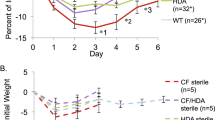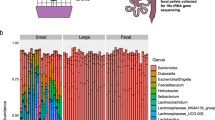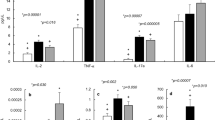Abstract
Lung disease is the major cause of death in cystic fibrosis (CF), but there is no evidence for overt lung involvement at birth. We show here that the same is true for the gene targeted cftrm1HGu mutant mouse. Furthermore, this CF mouse model demonstrates an impaired capacity to clear Staphylococcus aureus and Burkholderia (Pseudomonas) cepacia, two opportunistic lung pathogens closely associated with lung disease in CF subjects. The cftrm1HGU homozygotes display mucus retention and frank lung disease in response to repeated microbial exposure. Thus, lung disease in the cftrm1HGU mouse develops in response to bacterial infection, establishing a model to dissect the pathogenesis of CF pulmonary disease and providing a clinically relevant end point to assess the efficacy of pharmacologic or genetic interventions.
This is a preview of subscription content, access via your institution
Access options
Subscribe to this journal
Receive 12 print issues and online access
$209.00 per year
only $17.42 per issue
Buy this article
- Purchase on Springer Link
- Instant access to full article PDF
Prices may be subject to local taxes which are calculated during checkout
Similar content being viewed by others
References
Riordan, J.R. et al. Identification of the cystic fibrosis gene; cloning and characterization of complementary DNA. Science 245, 1066–1073 (1989).
Boat, T., Welsh, M.J. & Beaudet, A. Cystic Fibrosis In The Metabolic Basis of Inherited Disease (eds Scriver, C.L., Beaudet, A.L., Sly, W.S. & Valle, D.) 2649–2680 (McGraw-Hill, New York, 1989).
Kerem, B.-S. et al. Identification of the cystic fibrosis gene: genetic analysis. Science 245, 1073–1079 (1989).
The cystic fibrosis genotype-phenotype consortium: correlation between genotype and phenotype in patients with cystic fibrosis. New Engl. J. Med. 329, 1308–1312 (1993).
Mearns, M., Fibrosis: the first 50 years. In Cystic Fibrosis Current Topics Volume 1 (eds Dodge, J.A., Brock, D.J.H. & Widdicombe, J.H.) 217–250 (J. Wiley & Sons, Chichester, 1992).
Oppenhelmer, E.H. & Esterley, J.R. Pathology of cystic fibrosis: review of the literature and comparison with 146 autopsied cases. In Perspectives in Pediatric Pathology Volume 2 (eds Rosenberg, H.S. & Bolande, R.P.) 241–278 (Yearbook Medical Publishers, New York, 1976).
Gilligan, P.M. Microbiology of airway disease in patients with cystic fibrosis Clin. Microbiol. Rev. 4, 35–51 (1991).
Govan, J.R.W. & Nelson, J.W. Microbiology of cystic fibrosis lung infections: themes and issues. J. Royal Soc. Med. 20 (Suppl), 11–18 (1993).
Dorin, J.R. et al. Cystic fibrosis in the mouse by targeted insertional mutagenesis. Nature 359, 211–215 (1992).
Dorin, J.R. et al. Long term survival of the exon 10 insertional cystic fibrosis mutant mouse is a consequence of low level residual wild type Cftr gene expression. Mamm. Genome 5, 465–472 (1994).
Dorin, J.R., Alton, E.W.F.W. & Porteous, D.J. Mouse models for cystic fibrosis. in Cystic Fibrosis: Current Topics Volume 2 (eds Dodge, J.A., Brock, D.J.H. & Widdicombe, J.H.) 3–31 (J. Wiley & Sons, Chichester, 1994).
Highsmith, W.E. et al. A novel mutation in the cystic fibrosis gene in patients with pulmonary disease but normal sweat chloride concentrations. New Engl. J. Med. 331, 974–980 (1994).
Sheppard, D.N. et al. Mutations in CFTR associated with mild-disease form Cl channels with altered pore properties. Nature 362, 160–164 (1993).
Snouwaert, J.N. et al. An animal model for cystic fibrosis made by gene targeting. Science 257, 1083–1088 (1992).
Ratcliff, R. et al. Production of a severe cystic fibrosis mutation in mice by gene targeting. Nature Genet. 4, 35–41 (1993).
O'Neal, W.K. et al. A severe phenotype in mice with a duplication of exon 3 in the cystic fibrosis locus. Hum. molec. Genet. 2, 1561–1569 (1993).
Anon. Pseudomonas cepacia- more than a harmless commensal. Lancet 339, 1385–1386 (1992).
Isles, A. et al. Pseudomonas cepacia infection in cystic fibrosis: an emerging problem. J. Pediatr. 104, 206–210 (1984).
Tablan, O.C. et al. Colonization of the respiratory tract with Pseudomonas cepacia in cystic fibrosis patients: risk factors and outcomes. Chest 91, 527–532 (1987).
Govan, J.R.W. et al. Evidence for transmission of Pseudomonas cepacia by social contact in cystic fibrosis. Lancet 342, 15–19 (1993).
Govan, J.R.W. & Nelson, J.W. Microbiology of lung infection in cystic fibrosis. Brit. Med. Bull. 48, 912–930 (1992).
Kubesch, P. et al. Genetic determinants of airways' colonisation with Pseudomonas aeruginosa in cystic fibrosis. Lancet 341, 189–193 (1993).
Nelson, J.W., Butler, S.L., Krieg, D. & Govan, J.R.W. Virulence factors of Burkholderia cepacia. FEMS Immunol. Med. Microbiol. 8, 89–98 (1994).
Yeates, D.B., Sturgess, J.M., Kahn, S.R., Levison, H. & Aspin, N. Mucociliary transport in trachea of patients with cystic fibrosis. Arch. Dis. child. 51, 28–33 (1976).
Wood, R.E., Wanner, A. & Hirsch, J.A. Measurement of mucociliary airway clearance in patients with cystic fibrosis and its stimulation with terbutaline. Pediatr. Res. 8, 471–475 (1974).
Smith, S. et al. Airway and intestinal bioelectric characteristics of the exon 10 insertional mouse model of cystic fibrosis: comparison with the features in man. Am. J. Physiol. (in the press).
Caplen, N. et al. Liposome-mediated CFTR gene transfer to the nasal epithelium of patients with cystic fibrosis. Nature Med. 1, 39–46 (1995).
Englehardt, J.F. et al. Submucosal glands are the predominant site of CFTR expression in human bronchus. Nature Genet. 2, 240–248 (1992).
Knowles, M., Gatzy, J. & Boucher, R.C. Increased bioelectric potential difference across respiratory epithelia in cystic fibrosis. New Engl. J. Med. 305, 1489–1495 (1981).
Alton, E.W.F.W. et al. Nasal potential difference: a clinical diagnostic test for cystic fibrosis. Thorax 47, 1010–1014 (1992).
Hyde, S. et al. Correction of the ion transport defect in cystic fibrosis transgenic mice by gene therapy. Nature 362, 250–255 (1993).
Author information
Authors and Affiliations
Rights and permissions
About this article
Cite this article
Davidson, D., Dorin, J., McLachlan, G. et al. Lung disease in the cystic fibrosis mouse exposed to bacterial pathogens. Nat Genet 9, 351–357 (1995). https://doi.org/10.1038/ng0495-351
Received:
Accepted:
Issue Date:
DOI: https://doi.org/10.1038/ng0495-351
This article is cited by
-
Biokinetics of nanoparticles and susceptibility to particulate exposure in a murine model of cystic fibrosis
Particle and Fibre Toxicology (2014)
-
Role of CFTR expressed by neutrophils in modulating acute lung inflammation and injury in mice
Inflammation Research (2011)
-
Pathogenicity, virulence factors, and strategies to fight against Burkholderia cepacia complex pathogens and related species
Applied Microbiology and Biotechnology (2010)
-
Spontaneous rescue from cystic fibrosis in a mouse model
BMC Genetics (2006)
-
Expression of S100A8 correlates with inflammatory lung disease in congenic mice deficient of the cystic fibrosis transmembrane conductance regulator
Respiratory Research (2006)



